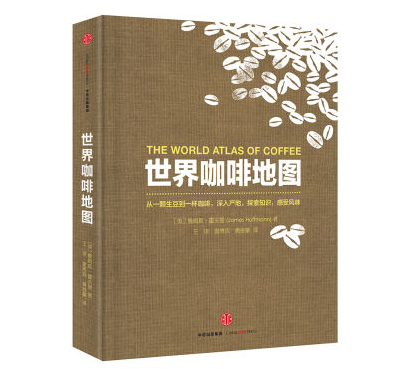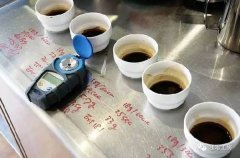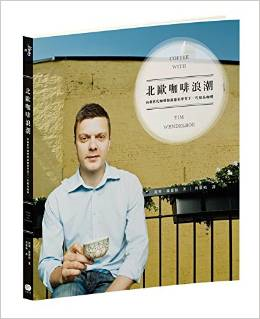Coffee book recommendation: "World Coffee Map" the World Atlas of Coffee

Chinese title: world Coffee Map
Original title: the World Atlas of Coffee
Author: James Hoffman (British, James Hoffmann)
Citic publication
The words written in the front:
In this way, it is a 2014 book. At that time, I was so attracted by the appearance and content of the book that I couldn't wait to write about it. What I didn't know at that time was that thinking about it must reverberate.
Between two years, here and there, I will meet this book from time to time. The most impressive one, around the New year, Huo Xiansen on the coffee market a series of articles, shared by friends, read a lot of emotion. If you are interested, you might as well find and read it.
Then, there was a book shortage for more than half a year, obsessed with friends' questions about "do you have a book recommendation?" in late summer and early autumn, the Chinese version of the Coffee Map of the World was in hand.
When I heard that there was going to be a Chinese version, my friends wanted to recommend it, but because someone had not actually read the translation, they did not have the strength to make a definite recommendation. Now, someone who has finally finished playing with the Chinese text can be down-to-earth.
Nagging.
Read a book.
Books are suitable for:
1. Beginners.
If the interest in coffee is more than just going to a restaurant in Xinshui to taste it with a familiar barista, or enjoying sharing one or two things about coffee with baristas, then this book will be a good introduction.
2. Baristas, or coffee shop owners who are enthusiastic about coffee expertise.
To be honest, this book is more of a popular kind of reading, technical experts please automatically avoid O (∩ _ ∩) O.
I hope to make my coffee knowledge more systematic. Although I have been learning in my own way and have an overall and objective understanding of coffee knowledge, I always feel that I lack a logic to connect the knowledge in my mind, or, I often think that I am very clear about the subject, but I find that there is a lack of necessary details when discussing with customers. If this is the case, it is recommended to read the book carefully from beginning to end.
Special hint:
1. This book as a whole is an introduction to the basic knowledge of coffee, which basically covers the whole process from seed to cup, and the knowledge involved is relatively complete. Accordingly, the depth of each knowledge point is general. Please pay attention to this.
2. Do you have a drink recipe or something?
There is no content of beverage formula. On the other hand, the coffee producing area information is more comprehensive, the existing boutique coffee market is basically covered, and the introduction of each origin even takes care of the coffee history, which is rare. Specific to the small production areas, but also according to the consumption habits of boutique coffee, varieties, altitude and other information are introduced. What's more, the two producing areas of Vietnam and India are rarely introduced in detail.
3. Do you have any instructions on how to make coffee?
In the part of coffee extraction, this paper briefly introduces the use of several common coffee utensils, such as hand brewing, mocha pot, Philharmonic pressure, siphon pot and Italian coffee machine, which are limited to the degree of conventional use and are not as meticulous and in-depth as special books.
Is coffee roasting involved?
As an important link from the seed to the cup, baking is definitely going to be talked about. As for depth, it is still the level of basic knowledge, such as the various stages of baking, the basic principles of baking. It does not involve the technical level of the actual operation, but occasionally gives some experience as an experienced person.
5. Espresso should be paid attention to.
The author was born as a WBC champion, and there are still a lot of references in the relevant narration. In addition, thanks to the author's qualifications, the way of telling is also cute and tight, such as the classic Terrier of Cabo "1:1:1" that baristas will meet. That's what I was taught at the beginning of my coffee career. " Baristas have read that it is too late to meet each other. Is there any O (∩ _ ∩) O?
In addition, the expressions of several classic Italian drinks are also worth paying attention to. A copy of "Flat White" actually has such a funny legend that it is drunk O (∩ _ ∩) O.
About this book.
When I read the original edition, I felt that the neatly arranged letters were lovely. If I didn't read the content, I just flipped through it, and I also thought it would be a down-to-earth writing book.
Unexpectedly, after it was translated into Chinese, someone turned it over, there are too many words, look at the published information, more than 300,000?! It's too real! I want to say that when I read foreign words, on the one hand, I will feel fresh and leisurely to read them, but after changing the cost home words, it will feel really different. I need to take a deep breath and someone should seriously study for a while to realize the sense of perception.
Fortunately, it is the hardcover version, paper quality, pictures, in short, book design is the best work available, a bit grand but also enjoyable. Occasionally, a sense of ritual brings a different experience.
The whole book, according to the custom of regular coffee books, half tells the basics from seeds to cups, and half, like a dictionary, introduces well-known coffee producing areas one by one.
The author is divided into three chapters, the process from seed to cup, the author is divided into two parts: the first part, about the relevant content of the coffee producing place, that is, the past plants, varieties, processing and trade of beans in the coffee farm; the second part, about the fate of coffee shops or coffee consuming countries, roasting, grinding, extraction, evaluation.
Such a separate description now seems to be quite reasonable, at least it can make it easier for readers to find the parts they are interested in, especially the general public. Basically, it is easier for people to learn familiar things. When you read, you can get what you want.
This time, the Chinese version will naturally have more relevant information. Someone saw the author's picture for the first time, on the page of the book introduction. It's a far cry from what I imagined. I don't know when I started to think of independent cafes and the third wave of trendy (it's not trendy now), it's hipsters and tattoos. There must be no lack of such experience in many trendy stores in China.
When I was reading, I was very interested in the literal style. I am glad that the Chinese translation version retains this reading experience, and the text conversion will indeed be difficult at some times. This is also the reason why many friends are willing to work hard on the original. However, I can happily feel that the translator of this book is trying very hard to interpret the mood of the original text and, better yet, the translation of many details. It's very tasty. As a translation version, the translation of this edition should be praised.
The overall style of the book is rational and simple, and the description of the text is very pertinent. More importantly, thanks to the author's rich practical experience, compared with the general accumulation of knowledge, the author's experience is increased. For example, when it comes to boutique producing areas, the history or famous product information of each producing area can be easily collected by the network, but the problems that may be encountered in the actual operation can be paid a little attention to. The author inadvertently reveals the expert experience.
The whole is rational and objective, but in some details, the author will also clearly express his views, such as the animal protection issues of Kopi Luwak, such as the ecological and environmental issues we talk about from time to time. In fact, when reading these details, there will still be some feelings other than coffee.
Now, organic, environmental protection, but also more often appear in people's daily life, when ordinary people think of these, more forced by the surrounding atmosphere, such as food safety. The concepts of environmental protection and sustainable development are actually much stranger to ordinary people. as far as coffee bean bags are concerned, cost and practicality will undoubtedly be the focus of inspection, and how many people will voluntarily pay attention to the environmental protection of the bags. The author mentioned that in a natural state, this is due to national conditions and cultural differences.
The author is a practical worker, so the description of many links is more objective and rational. Understanding coffee knowledge is on the one hand, people's choice is much more complex, what is the benchmark of people's choice of each link, can not be explained clearly by a sentence of right or wrong.
The content of this book is comprehensive, well-organized, the text is smooth, and the explanation of knowledge points is simple and meticulous. It is better as an auxiliary reading material for coffee learning. It's a bit like buying other people's study notes, if you also have the habit of taking notes, then O (∩ _ ∩) O.
Coffee knowledge, some are constant, some are constantly updated, according to the existing books, this book is the closest to the current popular reading of the coffee industry.
WBC champion barista, with his own bakery, irregularly updated web logs, can freely control the text to fully express himself, such a pragmatic author and his works will not be disappointed.
Think about the coffee life of the author.
With the help of my famine, let's first set a small goal that can be achieved.
How about going to Square Mile in London for a cup of Yejia brewed by Lord Huo himself?
Important Notice :
前街咖啡 FrontStreet Coffee has moved to new addredd:
FrontStreet Coffee Address: 315,Donghua East Road,GuangZhou
Tel:020 38364473
- Prev

The advance of coffee beginners: 3 steps to teach you how to taste a single cup of coffee?
Taste senses are actually a mixed sensory experience that combines many aspects of the body, such as taste, smell, touch, vision (studies have shown that vision can cause taste bias), and hearing (your taste senses are easily influenced subjectively by others). Although there are many authoritative criteria for measuring the quality of coffee, in order to let beginners understand coffee more quickly, we are here
- Next

Coffee Book recommendation: Nordic Coffee Wave "Coffee with Tim Wendelboe"
Original title: Coffee with Tim Wendelboe author: Tim Wendelboe Taiwan version translation title: Nordic Coffee Wave: learn the next generation of boutique coffee from the new generation barista Wen Debo translator: Zhou Yingming approach: Amazon purchase price: ¥80 this book, this cover, the man on the cover, has been hovering in my mind for a long time, when I think it's a nuisance.
Related
- Beginners will see the "Coffee pull flower" guide!
- What is the difference between ice blog purified milk and ordinary milk coffee?
- Why is the Philippines the largest producer of crops in Liberia?
- For coffee extraction, should the fine powder be retained?
- How does extracted espresso fill pressed powder? How much strength does it take to press the powder?
- How to make jasmine cold extract coffee? Is the jasmine + latte good?
- Will this little toy really make the coffee taste better? How does Lily Drip affect coffee extraction?
- Will the action of slapping the filter cup also affect coffee extraction?
- What's the difference between powder-to-water ratio and powder-to-liquid ratio?
- What is the Ethiopian local species? What does it have to do with Heirloom native species?

